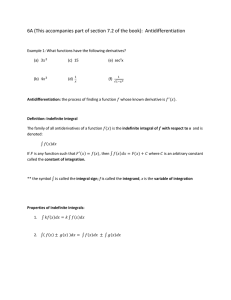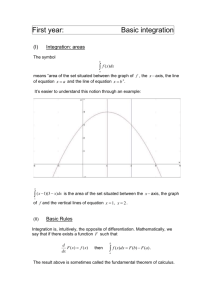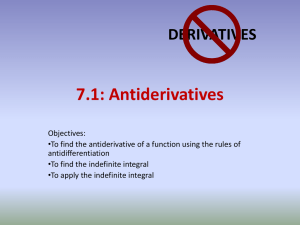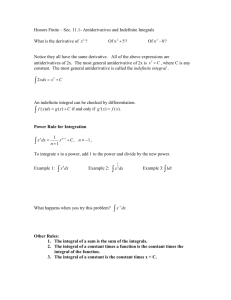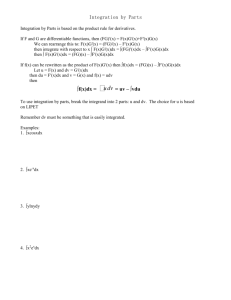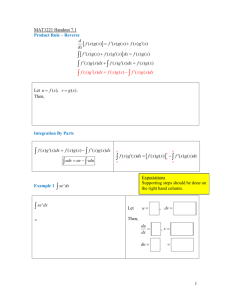6.1 Antiderivatives and the Rules of Integration
advertisement
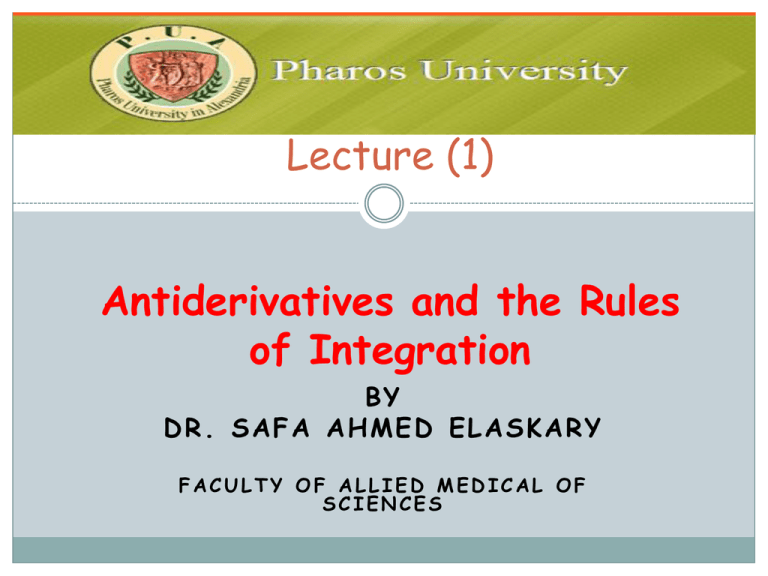
Lecture (1) Antiderivatives and the Rules of Integration BY DR. SAFA AHMED ELASKARY FACULTY OF ALLIED MEDICAL OF SCIENCES A function F is an antiderivative of f on an interval I if F’(x)=f(x) for all x in I. Let’s use an example to figure out what this statement means… Suppose we know f(x) = 2x and we want to find its antiderivative, F. If f(x) = 2x, then F’(x) = 2x. So we know the derivative of F. Think backwards, what function has a derivative equal to 2x ? F(x) = x² !!! To find the antiderivative, do the reverse of finding the derivative. Is F(x) = x² the only function whose derivative is 2x ? Or in other words, is F(x) = x² the only antiderivative of 2x ? Theorem 1: Let G be an antiderivative of a function f. Then, every antiderivative F of f must be of the form F(x) = G(x) + C, where C is a constant. So the answer to the question is F(x) = x²the only antiderivative of 2x is NO!! Example 1: Let F(x) = x² + 4 and let G(x) = x²- 1 Then F’(x) = 2x and G’(x)= 2x Thus both F and G are antiderivatives of f(x) = 2x. Note two functions which have the same derivative will only differ by the constant. This means the antiderivative of a function is a family of functions as pictured on the next slide. The Indefinite Integral The process of finding all antiderivatives of a function is called antidifferentiation, or integration. is the symbol used for integration and is called the integral symbol. We write f(x)dx F(x) C This is called an indefinite integral, f(x) is called the integrand and C is called the constant of integration. Basic Integration Rules Rule 1: kdx kx C (k, a constant) Keep in mind that integration is the reverse of differentiation. What function has a derivative k? kx + C, where C is any constant. Another way to check the rule is to differentiate the result and see if it matches the integrand. Let’s practice. Example 2: 2dx 2x C Example 3: 2 2 dx xC Before we list Rule 2, let’s go back and think about derivatives. When we used the power rule to take the derivative of a power, we multiplied by the power and subtracted one from the exponent. Example: d 3 x 3x2 dx Since the opposite of multiplying is dividing and the opposite of subtracting is adding, to integrate we’d do the opposite. So, let’s try adding 1 to the exponent and dividing by the new exponent. 31 x 1 4 Integrating: x3dx x 31 4 Check by differentiating the result: d 1 4 4 3 3 x x x dx 4 4 Since we get the integrand we know it works. Basic Integration Rules Rule 2: The Power Rule xn 1 x n 1 C Example 4: Find the indefinite integral Solution: t 3 dt t4 t dt C 4 3 Example 5: Find the indefinite integral Solution: n 1 n 3 x 2 dx 3 1 2 x 5 X2 x 3 2 dx 5 2 C C X2 C 3 5 5 1 2 2 Here are more examples of Rule 1 and Rule 2. 1 Example 6: Find the indefinite integral 3 dx x 1 Solution: x 3 dx x 3 x 31 x 2 1 C C 2 C 31 2 2x Example 7: Find the indefinite integral 1dx x C Solution: Example 8: Find the indefinite integral Solution: 1dx 3x 2 dx 3 x 2 2 3 x dx 3x 21 3x 1 3 C C C 2 1 1 x Basic Integration Rules Rule 3: The Indefinite Integral of a Constant Multiple of a Function cf(x)dx c f(x)dx, c is a constant Rule 4: The Sum Rule (or difference) fx gxdx f(x)dx g(x)dx fx gxdx f(x)dx g(x)dx Rule 5: e dx e Rule 6: 1 xdx ln x C x x C To check these 2 rules, differentiate the result and you’ll see that it matches the integrand. Example 9: Integrate. (2x 1 3 2 x 3e x )dx x x Using the sum rule we separate this into 5 problems. 1 3 x 2 xdx dx dx x dx 3 e x x2 dx Call them: 1 2 3 4 5 For 11 we will use rule 3 to bring the constant outside of the integral sign. 2 xdx Next we will use rule 2, the power rule to integrate. x11 x2 2 2 xdx 2 x2 2 1 1 Example 9 continues… 1 3 x 2 xdx dx dx x dx 3 e x x2 dx Call them: 1 For 2 1 2 3 4 5 2 2 xdx x we will use Rule 6 the natural log rule. 1 dx ln x x For 3 we will first rewrite then use the constant rule (Rule 3) and then the power rule (Rule 2). 21 1 3 x x 3 2 x2 dx 3 x dx 3 2 1 3 1 x Example 9 continues… 1 3 x 2 xdx dx dx x dx 3 e x x2 dx Call them: 1 2xdx x 2 1 2 2 3 4 1 dx ln x x 5 3 3 x dx 2 3 x For 4 we will rewrite and then use the power rule (Rule 2). 1 2 1 1 2 3 x 2 xdx x dx x2 1 1 3 2 For 55 we will use the constant rule (Rule 3) and then Rule 5 for ex. x x x 3 e dx 3 e dx 3 e Example 9 continues… 1 3 x 2 xdx dx dx x dx 3 e x x2 dx Call them: 11 2xdx x 2 2 3 44 3 1 dx x 2 dx x 3 ln x x xdx 2 23 x 3 5 3e x dx 3e x So in conclusion: 3 1 3 3 2 2 x 2 x 2 xdx dx dx x dx 3 e dx x ln x x 3 e C x x2 x 3 You may be wondering why we didn’t use the C before now. Let’s say that we had five constants C1 C2 C3 C4 C5 . Now we add all of them together and call them C. In essence that’s what’s going on above. Here are some for you to try: 1. Integrate and check your answer by taking the derivative. 3 x 4 e x dx Click the correct answer below. 3x 5x 5 e x C 3x 4x 3 e x C 3x 1 5 x ex C 5 Sorry that’s not correct. Think about the power rule for integration. You should add one to the exponent and divide by the new exponent. Try again. Return to the previous slide. Good Work!! Here is the solution in detail. 3 x 4 e x dx 3dx x 4 dx e x dx x 4 1 3x ex C 4 1 1 5 3x x e x C 5 2. Integrate. 2x 4 1 x2 3 dx x Click on the correct first step. Integrate each factor separately . x 2 1 4x 3ln x C x Multiply the two factors in the radicand together and combine the like terms. 6 10 4 2 dx x x Be careful !! Rule 4 states: fx gxdx f(x)dx g(x)dx fx gxdx f(x)dx g(x)dx This does NOT apply to multiplication or division. You should multiply the factors in the integrand, simplify and then use Rule 4 to integrate the terms. Multiply the two factors in the radicand together and combine the like terms. 2 4 12 6 2 dx x x x 6 10 4 2 dx x x Next use Rule 4 to integrate each term separately . 6dx 10 1 dx 4 x x 1 6x 10ln x 4 C 1 6x 10ln x 4 C x x 2 dx Let’s look at the solution to the problem: f’(x)= 3x2 - 4x + 8 f(1)= 9 Solution: First integrate both sides: 3x3 4x2 f(x) 8x C 3 2 Simplify: f(x) x3 2x2 8x C Now find C by using the initial condition. Substitute 1 for x and 9 for f(x) 9 1 21 81 C 9 1 28 C 9 7 C 2C 3 2 This gives the particular solution. f(x) x3 2x2 8x 2 Review - Basic Integration Rules Rule 1: kdx kx C (k, a constant) Rule 2: The Power Rule xn 1 x n 1 C n Rule 3: The Indefinite Integral of a Constant Multiple of a Function cf(x)dx c f(x)dx, c is a constant Rule 4: The Sum Rule (or difference) fx gxdx f(x)dx g(x)dx fx gxdx f(x)dx g(x)dx x x e dx e C Rule 5: 1 Rule 6: xdx ln x C
